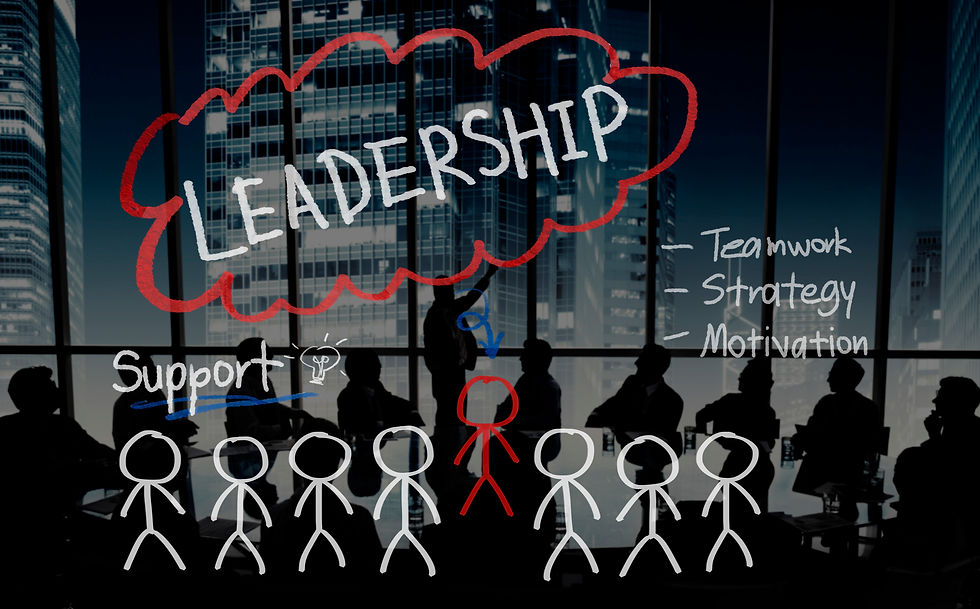The Point of Power: How Identifying One Low-Value Task Unlocks Your Highest Leadership Contribution
- Brian Goodwin
- 7 days ago
- 7 min read
Updated: 4 days ago
The Leader's Paradox of Engagement
The modern leader operates within a paradox: in an attempt to engage with everything, their capacity for meaningful engagement is critically diminished. The daily reality is a relentless influx of inputs—emails, meeting requests, project updates, and fleeting ideas—that creates a state of perpetual, reactive busyness. This condition, often mistaken for productivity, is in fact a crisis of attention management. The core of the issue lies in using the mind as a storage tool rather than the high-powered focusing tool it was designed to be.
This mental clutter is composed of what the Getting Things Done (GTD) methodology terms "stuff," "open loops," or "incompletes". These are the commitments, both large and small, made to oneself or to others that remain unfinished and untracked in a trusted system. The subconscious mind, however, does not differentiate between the urgency or importance of these open loops; an agreement to "replace the office printer toner" can occupy the same psychic RAM as the commitment to "finalize the Q3 strategic plan". This leads to a persistent, low-grade anxiety, born from an inverse relationship: the more unprocessed items on one's mind, the less likely any of them are to be completed effectively.
This state of cognitive overload forces leaders to default to tasks that are easiest, most visible, or simply the most recent interruption, rather than those that are most important. A single, recurring low-value task on a leader's plate is not an isolated inefficiency; it is a clear symptom of this deeper systemic failure. Its persistence is evidence of a workflow that lacks a rigorous process for capturing and clarifying commitments. Therefore, identifying this one task is not merely about reclaiming a few minutes. It is the first step in diagnosing and repairing the entire personal management system that allowed a low-impact item to command a high-value resource: the leader's attention.
Achieving a 'Mind Like Water': The Prerequisite for Strategic Thought
The antidote to the leader's state of constant, stressful reactivity is a state of readiness and appropriate engagement best described by the martial arts metaphor, "mind like water". A placid pool of water responds to stimulus with perfect economy: a small pebble creates a small ripple, while a large boulder creates a large splash. In both instances, the water responds appropriately to the force and mass of the input, and then returns to a state of calm. This is the model for a mind that is fully present and engaged, reacting with the precise energy required by the situation, rather than over- or under-reacting due to pre-existing stress and distraction.
This state is not an innate personality trait or a mystical gift bestowed upon a select few. It is the direct, achievable outcome of a disciplined process: externalizing 100% of one's commitments into a trusted system outside the mind. The human brain is a magnificent engine for creativity, innovation, and strategic thought, but it is a notoriously unreliable office for remembering appointments and to-do lists. The objective of the GTD methodology is to "close" all open loops, not necessarily by finishing them, but by capturing them, defining their desired outcomes, and identifying the very next action required to move them forward—all within a system that is reviewed regularly.
When a leader believes, "I'm just not an organized person," they are misdiagnosing a methodological failure as a character flaw. Clarity is not something a person is; it is something a person does. It is manufactured through the consistent application of an external process. The ultimate promise of this practice is the creation of mental and emotional "space." As the founder of GTD, David Allen, notes, high-value activities like creativity, strategic planning, and simple presence do not require more time; they require more space. The simple exercise of identifying one low-value task is the first practical step in the process of manufacturing that space.
The Keystone Effect: Why 'Just One' Task Changes Everything
Focusing on a single task as the starting point for a leadership shift is a deliberate strategy grounded in the science of behavioral change. Grand, sweeping resolutions to "get organized" or "be more strategic" often fail because they depend on high levels of motivation, which is a finite and unreliable resource. The principles of "tiny habits" or "atomic habits" demonstrate that small, manageable actions are far more effective because they bypass our natural resistance to change, require minimal effort to initiate, and can become automatic over time. Identifying just one task is a "two-minute rule" for personal transformation—an action so small and clearly defined that it becomes almost impossible not to do.
This single act of identification and processing functions as a "keystone habit"—a small change that precipitates a cascade of other positive behaviors. Research on keystone habits shows, for example, that individuals who begin a consistent exercise routine often start eating better and improving their productivity without consciously planning to do so. In the same way, the act of consciously evaluating one task builds the mental muscles of awareness and self-discipline, creating momentum that naturally spills over into other areas of a leader's work. This small win builds confidence in the process, creating a positive feedback loop that encourages further engagement.
The most profound transformation, however, occurs at the level of identity. True, lasting behavioral change is identity change. The goal is not simply to run, but to become a runner. Every action a leader takes is a "vote" for the type of professional they wish to be. When a leader blindly reacts to their inbox, they cast a vote for the identity of "reactive manager." But when they pause to identify a low-value task and consciously decide to eliminate, delegate, or defer it, they cast a powerful vote for a new identity: "a strategic operator who protects their focus and directs resources effectively." This is not about thinking one's way into a new way of acting; it is about acting one's way into a new way of thinking.
The One-Task Audit: A Practical Framework for Gaining Awareness
Moving from the abstract principle to concrete action requires a simple, repeatable process. This audit provides a framework for any leader to execute the shift from awareness to decision.
Step 1: Capture (The Mind Sweep)
The process must begin by externalizing the mental inventory. A leader should take ten minutes and conduct a "mind sweep," writing down every single task, commitment, or "incomplete" that currently has their attention, no matter how large or small. The goal is not a perfect or exhaustive list, but a rapid download of the "stuff" currently occupying mental space.
Step 2: Clarify (The 80/20 Filter)
With the list captured, the leader can now review it through the lens of the Pareto Principle, which posits that 80% of results typically come from 20% of efforts. The objective is to scan the list and identify just ONE task that clearly falls into the 80% of effort that yields minimal strategic results. Diagnostic questions can guide this selection: "Does this task leverage my unique skills and authority?" "If this were the only thing I accomplished today, would it significantly advance my most important objectives?" "Could someone else on my team do this at least 80% as well as I could?".
Step 3: Organize (The Decision Matrix)
Once a single low-value task is identified, it must be processed decisively. This prevents it from being mentally shelved and returning to the pool of ambient anxiety. The following matrix provides a clear workflow, transforming the identified task from a source of clutter into a catalyst for control.
Diagnostic Question | If YES: Next Step | If NO: Next Step | GTD Principle Applied |
1. Is this task truly necessary for any desired outcome? | Proceed to Question 2. | Eliminate: Trash the task. Reclaim the bandwidth. | Trash |
2. Am I the uniquely qualified person to execute this? | Proceed to Question 3. | Delegate: Identify the right person and assign with a clear outcome. Add to 'Waiting For' list. | Delegate / Waiting For |
3. Does this require more than one action step to complete? | Define as Project: Clarify the successful outcome. Determine the very next physical action. Add to 'Projects' list. | Proceed to Question 4. | Project / Next Action |
4. Does it need to be done at a specific time or day? | Defer (Schedule): Place it on the calendar. | Defer (List): Add to the appropriate 'Next Actions' list (e.g., @Calls, @Office). | Calendar / Next Actions List |
From Ground Level to the Horizon: Connecting Daily Actions to Ultimate Vision
This simple act of processing one task is more than a productivity tweak; it is a profound leadership discipline. It is the foundational practice that connects the tactical world of daily actions to the strategic world of long-term vision. The GTD methodology provides a model for this connection through the "Horizons of Focus," a six-level framework for reviewing one's work and life.
Horizon 5: Life/Purpose
Horizon 4: Long-Term Visions (3-5 years)
Horizon 3: 1–2 Year Goals
Horizon 2: Areas of Focus and Accountability (e.g., Team Leadership, Financial Health, R&D)
Horizon 1: Current Projects
Ground: Current Actions (emails, calls, errands)
Critically, this model functions from the bottom up. A leader cannot effectively contemplate their long-term vision (Horizon 4) if their mind is consumed by unprocessed emails and nagging to-dos at the Ground level. Perspective is the product of control. By mastering the mundane, one earns the clarity required for the magnificent.
The engine that drives this bottom-up process is the Weekly Review, a dedicated time to reflect on all horizons and ensure alignment. However, an effective Weekly Review is only possible if the system is relatively clear of the week's unprocessed "stuff." The daily micro-habit of identifying and processing low-value tasks—the very skill initiated by this one-task audit—is the maintenance that keeps the system clean. It is the practice that transforms the Weekly Review from a stressful cleanup session into a powerful strategic reflection.

Ultimately, productivity for a leader is not measured by the number of tasks they complete. It is measured by the alignment of their actions (Ground) with their purpose (Horizon 5). True leadership effectiveness is the result of gaining total control at the most granular level to free up the mental capacity for perspective at the highest level. The journey to becoming a truly visionary leader begins not with a grand strategic plan, but with the simple, repeatable, and powerful act of identifying one thing that is not the best use of one's time—and dealing with it, completely.



Comments